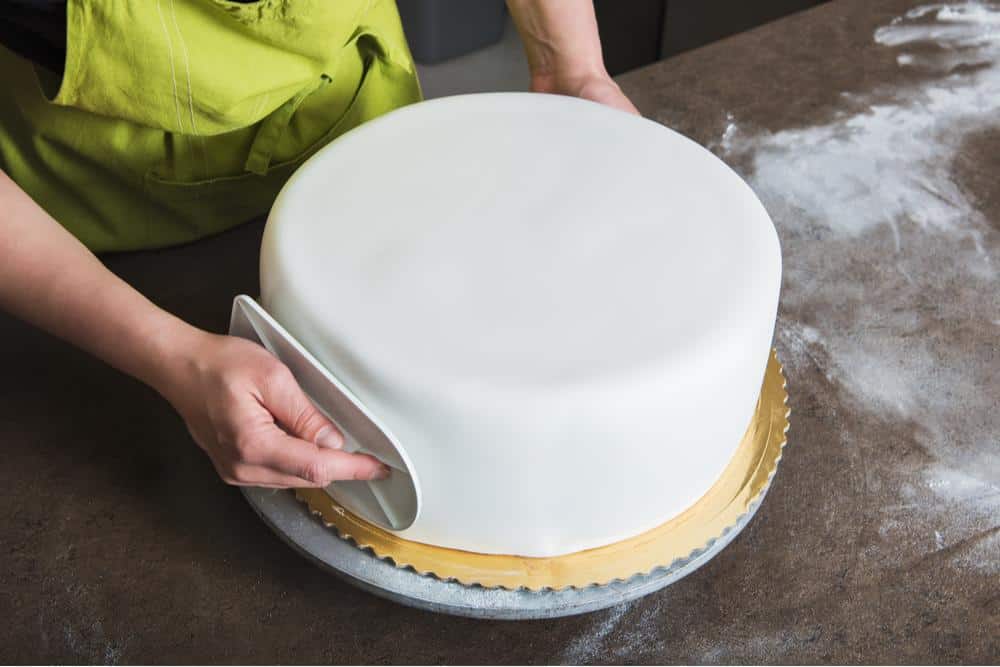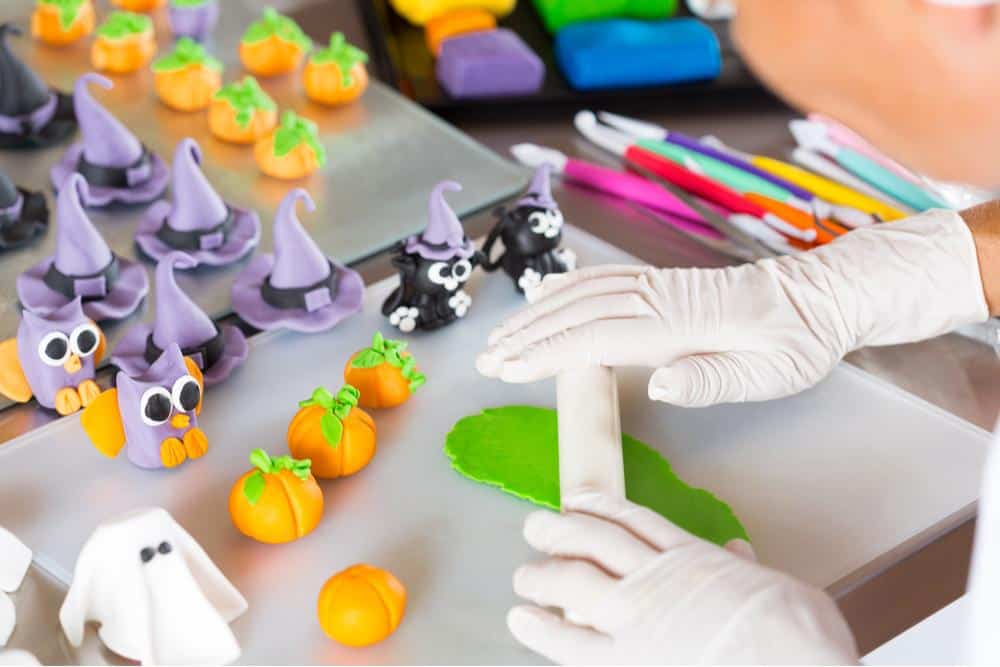Cake decorating can be a rewarding art. Not only do you get to play with buttercream, rolled fondant, and maybe even a cake topper, but you also get to provide a delicious treat. To create a true masterpiece, it is vital to know how to manage each component.
While buttercream frosting is simply delicious, a buttercream frosted cake is somewhat limiting from a decoration standpoint. Likewise, it is difficult to create an edible work of art with cream cheese frosting.
Fondant is a more versatile material if you want to decorate cakes with more detail than buttercream icing allows. Fondant decoration is an edible paste or clay-like substance consisting of a mixture of water, corn syrup, and pulverized sugar that is usually several times finer than powdered sugar. 
A Cake Decorated with Fondant Icing
Adding gelatin or glycerin can make the fondant decorations more moldable. You may also find a few variations of fondants that you can make or buy.
Fondant allows you to bring your cake creativity to a new level. If you want to get the best results possible with your fondant cake creations, keep them far away from a refrigerator. Do this whether your fondant is on a cake, in decorative shapes awaiting a cake, or stored as a leftover.
This ingredient is simple enough to use. However, it would be best to consider some factors when you use and store fondant to achieve the best results.
So, if you’re asking yourself, “Can you put fondant in the fridge?” read on to learn how to maintain this incredibly versatile cake staple.
Making Fondant Decor Animals (Food Network)
When fondant meets a refrigerator, the humidity inside the fridge can often negatively affect the texture of the fondant. The sugars attract moisture which can lead to softening and melting. As a result, your fondant decorations may lose their shape, and all your hard work is a waste.
This rule goes for a fondant covered cake as well, since the same issues can arise after the fondant is shaped into decorations and placed in the fridge. As a result, it is best to store any fondant cake at room temperature.
It is typical for decorations made out of fondant to be made in advance and stored before being added to a cake. This means that you can store filled cakes in the fridge without concern over whether or not your fondant decorations will suffer damage in the process.

Buttercream Icing Does Well in the Refrigerator - Unlike Fondant
So, it is a good idea to plan your cake fillings ahead. Avoid any components of your cake that will need refrigeration if you plan on making a fondant cake.
Such fillings include mousses, fresh fruit, and fillings that contain eggs, such as custard. Some fillings that do not need to be refrigerated are fruit preserves, gelled fillings, ganache, buttercream, and poached fruits.
The only exception to the rule when it comes to storing fondant in the fridge is quick-pour fondant. You can store it in the fridge in an airtight container. If you keep this fondant in the refrigerator, make sure that it has not changed taste before you work with it.
If you follow this simple rule, you will avoid awkward texture changes in your creations, and you will be able to make gorgeous cakes.
Whether you have finished fondant decorations or leftover fondant to store, you may want to know how to keep them safe until you are ready to use them. The way you store your fondant will depend on if you want it to be hard or soft.
If you want to keep your fondant soft, coat your decorations in a small amount of shortening to the outside of your finished decorations. This action seals in the moisture.
Plastic Wrap is Your Friend
You can also keep your decorations soft by storing them in plastic wrap or an airtight container. These decorations should last for about two months.
To dry your fondant decorations, place them on a piece of wax paper or parchment paper sprinkled with corn starch for a day or two. Store these decorations in an airtight container with more parchment paper in between the decorations. Dry decorations can last for three or four months. Keep in mind that dry decorations tend to be less palatable than soft decorations.
The answer to this question depends on how long your decorations are in the fridge, how damaged they are, if they are attached to a cake, and if you are willing to rework your decorations.
In general, the damage to your decorations will be more severe the longer they are in the fridge.
In some cases, you may be able to save the fondant itself even if you can not save the shape. Try re-rolling your decorations or melting them in the microwave. You can then fashion new creations and store them at room temperature.
If your decorations are already attached to a cake, your options may be somewhat more limited.
Try to remove the decorations from your cake to rework them. If doing this would damage the overall cake, you may want to see how much you can fix the decorations while they are on the cake.
Otherwise, you can cover any issues with new non-refrigerated fondant decorations, or you can get creative with other decorative elements.
Besides keeping fondant decorations in an airtight container and out of the fridge, it is vital to store your fondant in a dark area. It is also good to store your fondant in a dark and covered container.
You should do this because sunlight or artificial light can fade the colors of fondant. This rule is relevant whether fondant is on a cake or in the form of independent decorations. 
Treats with Fondant Icing do Best in Covered Containers Away from Light and Heat
In general, store both of these types of fondant similarly. Keep both of them out of the fridge and keep them in airtight containers. Store-bought fondant may be somewhat more forgiving when it comes to storage because it contains preservatives.
Some types of store-bought fondant can also be formulated with different climates in mind. For example, some of them work better in humid environments.
Marshmallow fondant is a type of fondant made from marshmallows and powdered sugar. It is easily made at home, and many people prefer the taste of this variety compared to other fondants.
Similar to other forms of fondant, marshmallow fondant does best when not stored in the fridge.
The moisture in a refrigerator can affect the texture of the marshmallow fondant, causing it to soften and melt. Instead, you should wrap the fondant in plastic wrap and store it in an airtight container at room temperature.
You may be wondering how long fondant will last if it is not refrigerated. The exact timeline will depend on the variety of fondant you have and how well it is stored. In general, you can expect fondant to last for at least two weeks at room temperature.
This substance can last so long because of the large amount of sugar present in fondant. High sugar levels in food can prevent the growth of bacteria and fungi.
If you have extra fondant, you may be wondering if you can freeze it for later. Unfortunately, it would be best if you did not freeze rolled fondant. Avoid this because the cold can negatively affect the flavor and texture of the fondant.
Unlike rolled fondant, home bakers can freeze quick-pour fondant. However, you must carefully thaw it for optimum results. Heat it back up slowly and at a low temperature.
You should also check the quality of the quick-pour fondant by tasting it and assessing its texture and flavor. This type of fondant can last in the freezer for several weeks.
